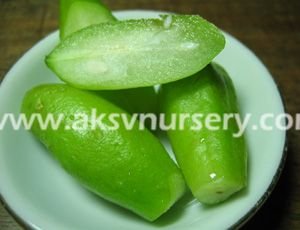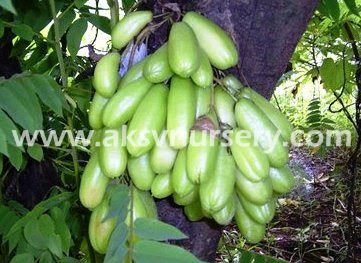Averrhoa bilimbi
Family: Oxalidaceae
Bilimbi, Cucumber Tree, Tree Sorrel, Kamias, belimbing asam, belimbing buloh
Origin: Moluccas
It is very common in Thailand, Malaya and Singapore. The bilimbi is closely allied to the carambola but quite different in appearance, manner of fruiting, flavor and uses. The only strictly English names are “cucumber tree” and “tree sorrel”. “Bilimbi” is the common name in India and has become widely used. The tree is attractive, reaches 35 ft in height. Small, fragrant, yellowish-green or purplish flowers marked with dark-purple, are borne in small, hairy panicles emerging directly from the trunk and oldest, thickest branches and some twigs, as do the clusters of curious fruits resembling small cucumbers that grow on strunk and stems. The bilimbi is generally regarded as too acid for eating raw, but in some places, the green, uncooked fruits are prepared as a relish. Ripe fruits are frequently added to curries in the Far East or used in place of mango to make chutney. The fruit juice is popular for making cooling beverages on the order of lemonade. To reduce acidity, it may be first pricked and soaked in water overnight and boiled with sugar to make a jam or an acid jelly. Half-ripe fruits are salted, set out in the sun, and pickled in brine and can be thus kept for 3 months. A quicker pickle is made by putting the fruits and salt into boiling water. This product can be kept only 4 to 5 days. The flowers are sometimes preserved with sugar.




